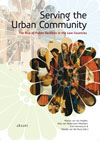Serving the Urban Community - The Rise of Public Facilities in the Low Countries

Amsterdam: Aksant, 2009. ISBN 978-90-5260-350-6, 286 pp.
Early modern towns in the Low Countries were famous for their effective urban institutions and social and economic facilities. Citizens made use of public roads and buildings, they settled their conflicts at judicial courts, and they appealed for assistance in times of need. Such early modern facilities were organized locally, in towns. A second feature is even more important: public duties were shared by town governments and churches, as well as numerous civil corporations. In the course of the early modern period urban governments became increasingly active and forceful in organizing and coordinating public services, sometimes at the expense of other providers of services. These transformations had an immediate impact on the relations between citizens and towns.
This volume explores various aspects of developments in public facilities in the early modern Low Countries. The Low Countries are an excellent case study for this purpose, because of its high levels of urbanization and the relevant comparison between the north and the south of the Netherlands.
Elise van Nederveen Meerkerk is working as a researcher at the IISH.
